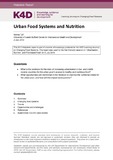| dc.contributor.author | Tull, Kerina | |
| dc.date.accessioned | 2018-08-30T14:39:07Z | |
| dc.date.available | 2018-08-30T14:39:07Z | |
| dc.date.issued | 2018-07-02 | |
| dc.identifier.citation | Tull, K. (2018) Urban Food Systems and Nutrition. K4D Helpdesk Report. Brighton, UK: Institute of Development Studies. | en |
| dc.identifier.uri | https://opendocs.ids.ac.uk/opendocs/handle/20.500.12413/14032 | |
| dc.description.abstract | This report provides an overview of the trends of urbanisation, the urban poor, and urban nutrition and how these trends affect urban food markets and food systems in low- and middle- income countries. Urbanisation is changing the food system in such a way that an increasing part of the global population will depend on purchased food. A large part of the food will be highly processed to meet the urban demand for food diversity, including meat and dairy products. The urban food market will become more internationally-oriented with longer supply chains, and with an increasing power shift to the retail industry (e.g. supermarkets). Formal food markets will mainly focus on rising demand for food from the middle classes.
Food availability is seldom the key factor contributing to undernutrition (‘hidden hunger’), which will continue to be a major challenge for the urban poor. As the urban population will continue to grow in low- and middle income countries (LMICs) the urban poor will not necessarily benefit from food diversity and booming formal urban food markets. Urban poor households in LMICs spend approximately 70% of their income on food, making them particularly vulnerable to food price crises and do not have the purchasing power to afford a healthy diet. They will rely on informal food markets.
Urbanisation is an important factor in changing eating patterns and nutrition trends, and also dramatically changes the structures of urban food markets. continued urbanisation in the current form incorporates many risks: increased risks related to poor health and undernutrition; “distancing” of food production via long-distance modern supply chains risks the growing issue of urban food waste; urban poor are especially hard hit by food price inflation and volatility, while price controls on primary products do not guarantee the stability of food prices. Inequalities in access to food not only risks instability, food riots, and an increase in violence in cities, but also reduces the economic opportunities of poor slum dwellers to increase their micro or small scale food businesses, risking unemployment. Increasing food demands of cities also create intense competition for land, as development encroaches on peri-urban agricultural land: substantial land use and land cover has occurred. | en |
| dc.language.iso | en | en |
| dc.publisher | IDS | en |
| dc.relation.ispartofseries | K4D Helpdesk Reports;383 | |
| dc.rights.uri | https://www.nationalarchives.gov.uk/doc/open-government-licence/version/3/ | en |
| dc.subject | Nutrition | en |
| dc.title | Urban Food Systems and Nutrition | en |
| dc.type | Other | en |
| dc.rights.holder | UK Government | en |
| dcterms.dateAccepted | 2018-08-30 | |
| rioxxterms.funder | Department for International Development, UK Government | en |
| rioxxterms.identifier.project | K4D | en |
| rioxxterms.version | VoR | en |
| rioxxterms.funder.project | 238a9fa4-fe4a-4380-996b-995f33607ba0 | en |

